
By Joseph Kellard
When you first encounter Sam Axton's bronze maquette sculpture "Joy," you are struck immediately by this beautiful woman’s lively mobility. Joy’s swinging arm and kicked-back leg evoke this animation, but it is the rousing sweep of her hair that lends it a distinct spice. Straight, layered and flowing, Joy's hair mirrors a bird’s wing in flight, streaming parallel along with her rearward-moving limbs to create the suggestion that she is poised to soar.
But if Joy’s hair were depicted differently, how might it alter this significant sensation? What if Mr. Axton opted instead to give Joy corkscrew hair, put her locks in a ponytail or allowed them to hang straight down or, worst of all, gave her with a short, pageboy cut? Clearly, this would have deflated her hint at flight.
 Similarly, if he had left more mass on her otherwise accentuated slim figure, he would have destroyed her airy elegance. Her smooth skin, perky breasts and taught thighs and buttocks already emphasize her womanly youth, each complimenting her signature weightlessness. If Mr. Axton made Joy fat or bulky or even gave her just some athletic musculature, each frame would have robbed her of the lightness of being that is integral to the theme of this work.
Similarly, if he had left more mass on her otherwise accentuated slim figure, he would have destroyed her airy elegance. Her smooth skin, perky breasts and taught thighs and buttocks already emphasize her womanly youth, each complimenting her signature weightlessness. If Mr. Axton made Joy fat or bulky or even gave her just some athletic musculature, each frame would have robbed her of the lightness of being that is integral to the theme of this work. To formulate that theme, we'll have to figure out what Joy is doing — what is her purpose?
First, we see that she's in the midst of sprinting, with her right leg striding forward. But where is she headed? Perhaps she's running from someone? If so, then why does she stretch her arm backward and hold her hand out as if reaching for something to grab? Is Joy in an athletic race, waiting for an imagined runner to pass her a baton?
If either scenario were plausible, though, Mr. Axton would have likely made Joy’s right foot or heel appear as if it were digging firmly into the ground. Instead, only the tips of her toes touch down, heightening her walking-on-clouds aura. Joy is not engaged in an intense relay race.
This is evidence further when we contemplate her relaxed, fearless face. Her eyes are wide and eager, her smile broad and effervescent, as if she's found something or, more likely, someone trailing her whom she admires or adores. This tells us that she’s reaching for someone’s hand, summoning this person to join her on her journey ahead.
Note also that Joy's right arm and hand are parallel to the ground, telling us that she seeks the hand of peer, an adult, not a child for whom she would otherwise have to reach down. More importantly, she rests her left hand on her chest. What do these details reveal and how do they integrate with what we've already come to discern about this sculpture? They are Joy's subtlest yet most telling features.
At first glance, her left hand seems to suggestively exclaim: "Do you mean me!," as if someone has made a claim about her. But observe that rather than point an accusatory finger at herself, her fingers are spread wide and evenly, touching ever so slightly but specifically on her left breast, as if her heart is aflutter — as if Joy is in love.
 With this, we can come to our theme, which is that with her sweeping hair and a sprint about to go airborne, while she beams radiantly and sashays forward, Joy embodies the ideal that romantic love can energize and inspire us to travel more happily, spiritedly and lightly through life.
With this, we can come to our theme, which is that with her sweeping hair and a sprint about to go airborne, while she beams radiantly and sashays forward, Joy embodies the ideal that romantic love can energize and inspire us to travel more happily, spiritedly and lightly through life.* Dianne Durante, author of Outdoor Monuments of Manhattan, offered me some valuable suggestions for this analysis.

























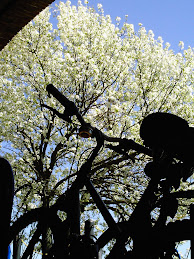



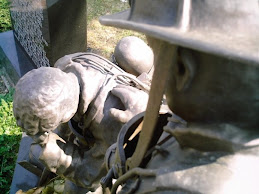
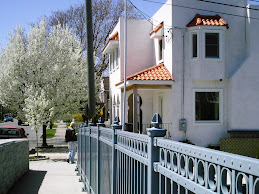
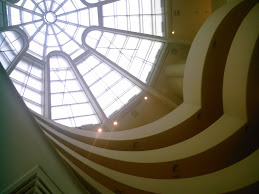+-+June+2009.jpg)


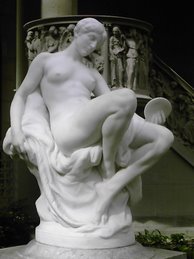


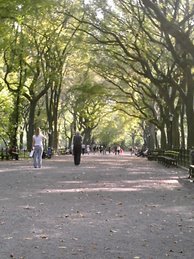


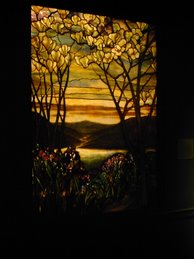


3 comments:
Nice to have a work of art to write intelligently about! More like this?
Jeff: Thanks for your reply and your good words about my post on "Joy." The next sculpture I would like to write about is "The Vine" by Harriet Frishmuth. So, yes, I do plan to write more posts like "Joy."
Sam Axton has allowed me to post this private comment he sent to me after reading my analysis of his sculpture "Joy."
“Thanks for your article on ‘Joy.’ It was spot on. You have very good observational skills.”
Post a Comment